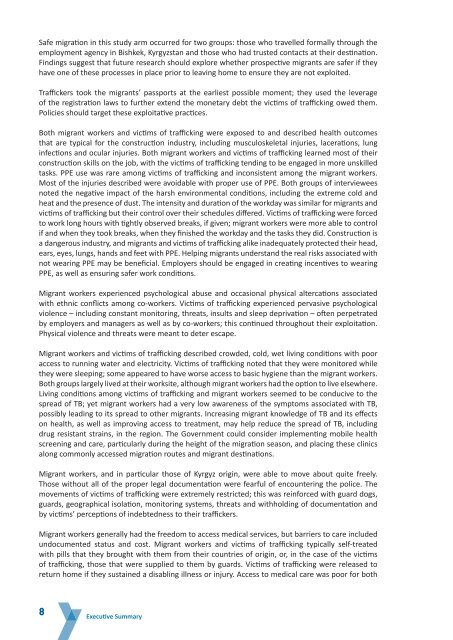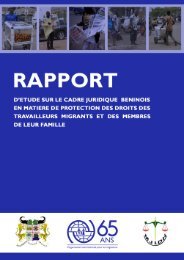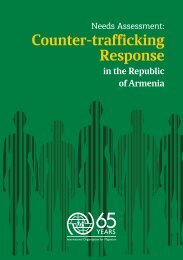Labour Exploitation Trafficking and Migrant Health
labour_exploitation_trafficking_en_0
labour_exploitation_trafficking_en_0
Create successful ePaper yourself
Turn your PDF publications into a flip-book with our unique Google optimized e-Paper software.
Safe migration in this study arm occurred for two groups: those who travelled formally through the<br />
employment agency in Bishkek, Kyrgyzstan <strong>and</strong> those who had trusted contacts at their destination.<br />
Findings suggest that future research should explore whether prospective migrants are safer if they<br />
have one of these processes in place prior to leaving home to ensure they are not exploited.<br />
Traffickers took the migrants’ passports at the earliest possible moment; they used the leverage<br />
of the registration laws to further extend the monetary debt the victims of trafficking owed them.<br />
Policies should target these exploitative practices.<br />
Both migrant workers <strong>and</strong> victims of trafficking were exposed to <strong>and</strong> described health outcomes<br />
that are typical for the construction industry, including musculoskeletal injuries, lacerations, lung<br />
infections <strong>and</strong> ocular injuries. Both migrant workers <strong>and</strong> victims of trafficking learned most of their<br />
construction skills on the job, with the victims of trafficking tending to be engaged in more unskilled<br />
tasks. PPE use was rare among victims of trafficking <strong>and</strong> inconsistent among the migrant workers.<br />
Most of the injuries described were avoidable with proper use of PPE. Both groups of interviewees<br />
noted the negative impact of the harsh environmental conditions, including the extreme cold <strong>and</strong><br />
heat <strong>and</strong> the presence of dust. The intensity <strong>and</strong> duration of the workday was similar for migrants <strong>and</strong><br />
victims of trafficking but their control over their schedules differed. Victims of trafficking were forced<br />
to work long hours with tightly observed breaks, if given; migrant workers were more able to control<br />
if <strong>and</strong> when they took breaks, when they finished the workday <strong>and</strong> the tasks they did. Construction is<br />
a dangerous industry, <strong>and</strong> migrants <strong>and</strong> victims of trafficking alike inadequately protected their head,<br />
ears, eyes, lungs, h<strong>and</strong>s <strong>and</strong> feet with PPE. Helping migrants underst<strong>and</strong> the real risks associated with<br />
not wearing PPE may be beneficial. Employers should be engaged in creating incentives to wearing<br />
PPE, as well as ensuring safer work conditions.<br />
<strong>Migrant</strong> workers experienced psychological abuse <strong>and</strong> occasional physical altercations associated<br />
with ethnic conflicts among co-workers. Victims of trafficking experienced pervasive psychological<br />
violence – including constant monitoring, threats, insults <strong>and</strong> sleep deprivation – often perpetrated<br />
by employers <strong>and</strong> managers as well as by co-workers; this continued throughout their exploitation.<br />
Physical violence <strong>and</strong> threats were meant to deter escape.<br />
<strong>Migrant</strong> workers <strong>and</strong> victims of trafficking described crowded, cold, wet living conditions with poor<br />
access to running water <strong>and</strong> electricity. Victims of trafficking noted that they were monitored while<br />
they were sleeping; some appeared to have worse access to basic hygiene than the migrant workers.<br />
Both groups largely lived at their worksite, although migrant workers had the option to live elsewhere.<br />
Living conditions among victims of trafficking <strong>and</strong> migrant workers seemed to be conducive to the<br />
spread of TB; yet migrant workers had a very low awareness of the symptoms associated with TB,<br />
possibly leading to its spread to other migrants. Increasing migrant knowledge of TB <strong>and</strong> its effects<br />
on health, as well as improving access to treatment, may help reduce the spread of TB, including<br />
drug resistant strains, in the region. The Government could consider implementing mobile health<br />
screening <strong>and</strong> care, particularly during the height of the migration season, <strong>and</strong> placing these clinics<br />
along commonly accessed migration routes <strong>and</strong> migrant destinations.<br />
<strong>Migrant</strong> workers, <strong>and</strong> in particular those of Kyrgyz origin, were able to move about quite freely.<br />
Those without all of the proper legal documentation were fearful of encountering the police. The<br />
movements of victims of trafficking were extremely restricted; this was reinforced with guard dogs,<br />
guards, geographical isolation, monitoring systems, threats <strong>and</strong> withholding of documentation <strong>and</strong><br />
by victims’ perceptions of indebtedness to their traffickers.<br />
<strong>Migrant</strong> workers generally had the freedom to access medical services, but barriers to care included<br />
undocumented status <strong>and</strong> cost. <strong>Migrant</strong> workers <strong>and</strong> victims of trafficking typically self-treated<br />
with pills that they brought with them from their countries of origin, or, in the case of the victims<br />
of trafficking, those that were supplied to them by guards. Victims of trafficking were released to<br />
return home if they sustained a disabling illness or injury. Access to medical care was poor for both<br />
8<br />
Executive Summary





